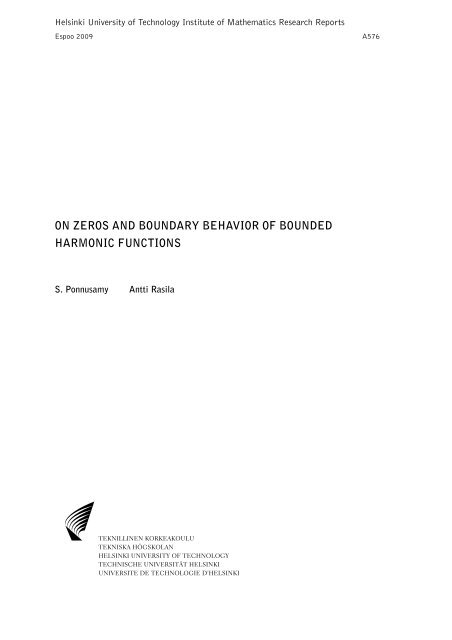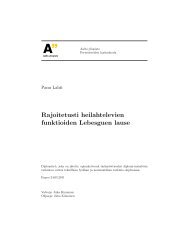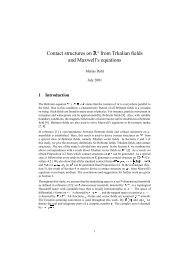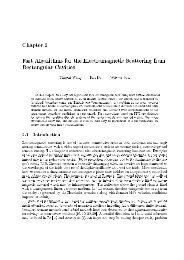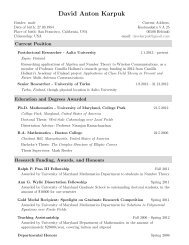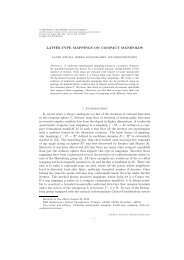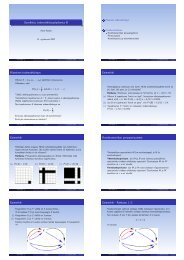on zeros and boundary behavior of bounded harmonic functions
on zeros and boundary behavior of bounded harmonic functions
on zeros and boundary behavior of bounded harmonic functions
Create successful ePaper yourself
Turn your PDF publications into a flip-book with our unique Google optimized e-Paper software.
Helsinki University <strong>of</strong> Technology Institute <strong>of</strong> Mathematics Research Reports<br />
Espoo 2009 A576<br />
ON ZEROS AND BOUNDARY BEHAVIOR OF BOUNDED<br />
HARMONIC FUNCTIONS<br />
S. P<strong>on</strong>nusamy Antti Rasila<br />
ABTEKNILLINEN KORKEAKOULU<br />
TEKNISKA HÖGSKOLAN<br />
HELSINKI UNIVERSITY OF TECHNOLOGY<br />
TECHNISCHE UNIVERSITÄT HELSINKI<br />
UNIVERSITE DE TECHNOLOGIE D’HELSINKI
Helsinki University <strong>of</strong> Technology Institute <strong>of</strong> Mathematics Research Reports<br />
Espoo 2009 A576<br />
ON ZEROS AND BOUNDARY BEHAVIOR OF BOUNDED<br />
HARMONIC FUNCTIONS<br />
S. P<strong>on</strong>nusamy Antti Rasila<br />
Helsinki University <strong>of</strong> Technology<br />
Faculty <strong>of</strong> Informati<strong>on</strong> <strong>and</strong> Natural Sciences<br />
Department <strong>of</strong> Mathematics <strong>and</strong> Systems Analysis
S. P<strong>on</strong>nusamy, Antti Rasila: On <strong>zeros</strong> <strong>and</strong> <strong>boundary</strong> <strong>behavior</strong> <strong>of</strong> <strong>bounded</strong> harm<strong>on</strong>ic<br />
functi<strong>on</strong>s; Helsinki University <strong>of</strong> Technology Institute <strong>of</strong> Mathematics Research<br />
Reports A576 (2009).<br />
Abstract: We study the c<strong>on</strong>necti<strong>on</strong> between multiplicities <strong>of</strong> the <strong>zeros</strong> <strong>and</strong><br />
<strong>boundary</strong> <strong>behavior</strong> <strong>of</strong> <strong>bounded</strong> analytic <strong>and</strong> harm<strong>on</strong>ic functi<strong>on</strong>s. We prove<br />
existence <strong>of</strong> angular (n<strong>on</strong>-tangential) limit at a <strong>boundary</strong> point provided that<br />
multiplicities <strong>of</strong> zeroes <strong>of</strong> the functi<strong>on</strong> grow fast enough <strong>on</strong> a given sequence<br />
<strong>of</strong> points approaching the <strong>boundary</strong>.<br />
AMS subject classificati<strong>on</strong>s: 30C15, 31A20<br />
Keywords: analytic <strong>and</strong> planar harm<strong>on</strong>ic functi<strong>on</strong>s, angular limits, multiplicity<br />
<strong>of</strong> zeroes<br />
Corresp<strong>on</strong>dence<br />
S. P<strong>on</strong>nusamy<br />
Indian Institute <strong>of</strong> Technology Madras<br />
Department <strong>of</strong> Mathematics<br />
Chennai 600 036<br />
India<br />
Antti Rasila<br />
Helsinki University <strong>of</strong> Technology<br />
Department <strong>of</strong> Mathematics <strong>and</strong> Systems Analysis<br />
P.O. Box 1100<br />
FI-02015 TKK<br />
Finl<strong>and</strong><br />
samy@iitm.ac.in, antti.rasila@tkk.fi<br />
ISBN 978-952-248-043-9 (print)<br />
ISBN 978-952-248-044-6 (PDF)<br />
ISSN 0784-3143 (print)<br />
ISSN 1797-5867 (PDF)<br />
Helsinki University <strong>of</strong> Technology<br />
Faculty <strong>of</strong> Informati<strong>on</strong> <strong>and</strong> Natural Sciences<br />
Department <strong>of</strong> Mathematics <strong>and</strong> Systems Analysis<br />
P.O. Box 1100, FI-02015 TKK, Finl<strong>and</strong><br />
email: math@tkk.fi http://math.tkk.fi/
1 Introducti<strong>on</strong><br />
A functi<strong>on</strong> f(z) is said to have a Lindelöf property in the unit disk D if whenever<br />
f(z) → α as z → z0 ∈ ∂D al<strong>on</strong>g some arc lying in D <strong>and</strong> terminating at<br />
z0, then f(z) → α uniformly as z → z0 inside any angular domain <strong>of</strong> opening<br />
π − ǫ in D with z0 as its vertex which is bisected by the radius drawn to z0.<br />
In this case, f(z) has the angular limit α at z0.<br />
The following classical result is known as Lindelöf’s theorem (see e.g. [12,<br />
p.259]):<br />
1.1 Theorem. Suppose that γ is a curve, with parametric interval [0, 1], such<br />
that |γ(t)| < 1 if t < 1 <strong>and</strong> γ(1) = 1. If f is a <strong>bounded</strong> analytic functi<strong>on</strong> <strong>of</strong><br />
the unit disk D <strong>and</strong><br />
lim<br />
t→1 f γ(t) = α,<br />
then f has angular limit α at 1.<br />
There are various generalizati<strong>on</strong>s <strong>of</strong> Lindelöf’s theorem in the literature.<br />
It is interesting to ask whether a weaker c<strong>on</strong>diti<strong>on</strong> would be sufficient for<br />
the result. Another related result is due to P. Koebe. He proved that if<br />
a <strong>bounded</strong> analytic functi<strong>on</strong> tends to zero al<strong>on</strong>g a sequence <strong>of</strong> arcs in the<br />
unit disk which approaches a subarc in the <strong>boundary</strong>, <strong>and</strong> if the Euclidean<br />
diameters <strong>of</strong> these arcs are <strong>bounded</strong> from below by a c<strong>on</strong>stant c > 0, then it<br />
must be identically zero [4, p.19]. A recent survey <strong>on</strong> the results <strong>of</strong> this type<br />
is given in [7]. For results c<strong>on</strong>cerning sequential limits, see also [2].<br />
This topic has been studied by several authors, in particular by Rung, who<br />
studied the c<strong>on</strong>necti<strong>on</strong> between the <strong>boundary</strong> <strong>behavior</strong> <strong>of</strong> analytic functi<strong>on</strong>s<br />
<strong>and</strong> the hyperbolic metric in [13]. In Rung’s results, the values attained by<br />
the functi<strong>on</strong> are assumed to approach a limit at a certain rate <strong>on</strong> a sequence<br />
<strong>of</strong> c<strong>on</strong>tinua <strong>of</strong> given hyperbolic diameter. By studying the balance between<br />
the rate <strong>of</strong> c<strong>on</strong>vergence <strong>and</strong> the growth <strong>of</strong> the hyperbolic diameter, <strong>on</strong>e can<br />
make c<strong>on</strong>clusi<strong>on</strong>s <strong>on</strong> the limit <strong>behavior</strong> <strong>of</strong> the functi<strong>on</strong>. For example, Rung<br />
proved the following result:<br />
1.2 Theorem. [13, Corollary 1] Suppose that γ is a <strong>boundary</strong> path in the<br />
unit disk D, <strong>and</strong> f is analytic in D such that for some w0 <strong>and</strong> for some<br />
positive functi<strong>on</strong> A(r), r ∈ [0, 1),<br />
for z ∈ |γ|, |z| ≥ r <strong>and</strong><br />
log |f(z) − w0| ≤ −A(r)<br />
(1 − |z|) ,<br />
lim inf<br />
r→1<br />
M(r,f)<br />
A(r)<br />
= 0,<br />
then f(z) ≡ w0. Here M(r,f) = max{sup log |f(z)|, 1}.<br />
|z|
2 Preliminaries<br />
Let f(z) be analytic at z0 <strong>and</strong> suppose that f(z0) = 0, but f(z) is not<br />
identically zero. Then f(z) is said to have a zero <strong>of</strong> order n at z0 if<br />
f(z0) = f ′ (z0) = · · · = f (n−1) (z0) = 0, <strong>and</strong> f (n) (z0) = 0.<br />
If f(z) is analytic at z0, <strong>and</strong> has zero <strong>of</strong> order n at z0, we write µ(z0,f) =<br />
n. We first recall the following well-known versi<strong>on</strong> <strong>of</strong> the classical Schwarz’<br />
lemma.<br />
2.1 Lemma. Let f : D → D be analytic with f(0) = 0 <strong>and</strong> µ(0,f) = p ≥ 1.<br />
Then<br />
|f(z)| ≤ |z| p for all z ∈ D.<br />
The hyperbolic metrics in the upper half plane H <strong>and</strong> in the unit disk D<br />
are defined by<br />
cosh ρH(z,w) = 1 +<br />
|z − w| 2<br />
, z,w ∈ H, (2.2)<br />
2 Im (z) Im (w)<br />
<strong>and</strong><br />
sinh 2<br />
<br />
1<br />
2 ρD(z,w)<br />
<br />
|z − w|<br />
=<br />
2<br />
(1 − |z| 2 )(1 − |w| 2 , z,w ∈ D, (2.3)<br />
)<br />
respectively. If there is no danger <strong>of</strong> c<strong>on</strong>fusi<strong>on</strong>, we denote both ρH(z,w) <strong>and</strong><br />
ρD(z,w) simply by ρ(z,w). A hyperbolic disk with the center z <strong>and</strong> the<br />
radius M > 0 is denoted by D(z,M).<br />
Both for (D,ρD) <strong>and</strong> (H,ρH) <strong>on</strong>e can define the hyperbolic distance in<br />
terms <strong>of</strong> the absolute ratio. Since the absolute ratio is invariant under Möbius<br />
transformati<strong>on</strong>s, the hyperbolic metric also remains invariant under these<br />
transformati<strong>on</strong>s. The pro<strong>of</strong> will use the hyperbolic form <strong>of</strong> Pythagoras’ Theorem.<br />
2.4 Lemma. [3, Theorem 7.11.1] For a hyperbolic triangle with angles α,β,π/2<br />
<strong>and</strong> corresp<strong>on</strong>ding hyperbolic opposite side lengths a,b,c, we have<br />
cosh c = coshacosh b.<br />
We have the following formula for z ∈ D:<br />
ρD(0,z) = log<br />
1 + |z|<br />
. (2.5)<br />
1 − |z|<br />
This relati<strong>on</strong> immediately yields that<br />
<br />
1<br />
|z| = tanh<br />
2 ρD(0,z)<br />
<br />
< 1, (2.6)<br />
where we have used the fact that<br />
tanhz = e2z − 1<br />
e2z + 1 .<br />
Let f : D → D be analytic. Then the following inequality holds for the<br />
hyperbolic distance (see for example [8, p. 268])<br />
<br />
f(x),f(y) ≤ ρD(x,y) for x,y ∈ D, (2.7)<br />
ρD<br />
where the equality holds if <strong>and</strong> <strong>on</strong>ly if f is a Möbius transformati<strong>on</strong>.<br />
4
3 Bounded analytic functi<strong>on</strong>s<br />
We will show a c<strong>on</strong>necti<strong>on</strong> between the multiplicity <strong>of</strong> the <strong>zeros</strong> <strong>and</strong> the<br />
<strong>boundary</strong> <strong>behavior</strong> <strong>of</strong> <strong>bounded</strong> analytic functi<strong>on</strong>s. A similar method <strong>of</strong> pro<strong>of</strong><br />
was used in the c<strong>on</strong>text <strong>of</strong> <strong>bounded</strong> quasiregular mappings <strong>of</strong> R n , n ≥ 2 in<br />
[11].<br />
3.1 Theorem. Let f : D → D be an analytic functi<strong>on</strong> with bk ∈ D such that<br />
f(bk) = 0 for all k = 1, 2,..., where bk → β ∈ ∂D, ρD(bk,bk+1) ≤ Mk < ∞<br />
<strong>and</strong> µk = µ(bk,f). If<br />
−Mk 1 − e<br />
1 + e−Mk µk<br />
→ 0 as k → ∞, (3.2)<br />
then f(z) has an angular limit 0 at β.<br />
Pro<strong>of</strong>. Let ρD(bk,bk+1) ≤ Mk. We may choose a Möbius transformati<strong>on</strong> hk<br />
such that hk(D) = D <strong>and</strong> hk(0) = bk. Then the functi<strong>on</strong> gk = f ◦ hk is<br />
analytic, gk : D → D <strong>and</strong> gk(0) = 0. Inequality (2.7), applied to h −1<br />
k with<br />
x = bk, y = bk+1 gives<br />
−1<br />
ρD 0,hk (bk+1) ≤ Mk.<br />
Let Rk = tanh( 1<br />
2 Mk) <strong>and</strong> µk = µ(bk,f). We see that gk has a zero <strong>of</strong> order<br />
µk at the origin. It follows by Lemma 2.1 <strong>and</strong> (2.6) that, for |z| ≤ Rk,<br />
or equivalently ρD(0,z) ≤ Mk. Thus<br />
|gk(z)| ≤ |z| µk ≤ R µk<br />
k<br />
|f(z)| ≤ R µk<br />
k for z ∈ [bk,bk+1], (3.3)<br />
where [bk,bk+1] is the line segment c<strong>on</strong>necting the points bk <strong>and</strong> bk+1. Let γ<br />
be the broken line joining the points bk <strong>and</strong> bk+1 for k = 1, 2,.... Because<br />
−Mk 1 − e<br />
1 + e−Mk µk<br />
→ 0 as k → ∞,<br />
we have<br />
From (2.5) we obtain<br />
<strong>and</strong> hence<br />
µk log<br />
1 + e−Mk<br />
1 − e −Mk<br />
→ ∞ as k → ∞. (3.4)<br />
e −Mk 1 − Rk<br />
= ,<br />
1 + Rk<br />
1 + e −Mk<br />
1 − e −Mk<br />
This observati<strong>on</strong> together with (3.4) yields<br />
= 1<br />
.<br />
Rk<br />
µk log Rk → −∞ or R µk<br />
k<br />
→ 0,<br />
as k → ∞. It follows by (3.3) that f has a limit al<strong>on</strong>g γ, <strong>and</strong>, by Theorem<br />
1.1, f has an angular limit 0 at β.<br />
5
3.5 Corollary. Let f : D → D be an analytic functi<strong>on</strong> with bk ∈ D such that<br />
f(bk) = 0 for all k = 1, 2,..., where bk → β ∈ ∂D, ρD(bk,bk+1) ≤ M < ∞<br />
<strong>and</strong> µ(bk,f) → ∞. Then f(z) has an angular limit 0 at β.<br />
3.6 Example. Let bk = 1 − 2 −k <strong>and</strong> µk = k for k = 1, 2,.... Then<br />
∞<br />
µk(1 − bk) =<br />
k=1<br />
∞<br />
k2 −k = 2 < ∞,<br />
k=1<br />
<strong>and</strong> hence by [5, Theorem 2.4], <strong>on</strong>e may c<strong>on</strong>struct an analytic functi<strong>on</strong> B(z)<br />
whose <strong>zeros</strong> are precisely {bk} with respective multiplicities µk. It follows<br />
from Corollary 3.5 that B(z) has angular limit 0 at 1.<br />
3.7 Remark. It is possible to c<strong>on</strong>struct a Blaschke product B0: D → D<br />
with infinitely many zeroes bk <strong>on</strong> the positive real axis such that bk → 1 <strong>and</strong><br />
µ(bk,B0) → ∞ as k → ∞, but B0 does not have an angular limit at 1. A<br />
c<strong>on</strong>structi<strong>on</strong> due to P. Lappan is given in [11, 5.21].<br />
3.8 Theorem. Let f : D → D be an analytic functi<strong>on</strong> with bk ∈ D such that<br />
f(bk) = 0 for all k = 1, 2,..., where bk → 1 <strong>and</strong> µk = µ(bk,f). If<br />
then f ≡ 0 <strong>on</strong> D.<br />
lim inf<br />
k→∞ |bk| µk = 0,<br />
Pro<strong>of</strong>. Let hk be a Möbius transformati<strong>on</strong> such that hk(D) = D, hk(0) = bk,<br />
<strong>and</strong> gk = f ◦ hk, as before. By Lemma 2.1, we have<br />
<strong>and</strong> hence<br />
where<br />
|gk(z)| ≤ |bk| µk for |z| ≤ |bk|,<br />
|f(z)| ≤ R µk for z ∈ D(bk,Mk),<br />
Mk = ρD(0, |bk|) = 1 1 + |bk|<br />
log<br />
2 1 − |bk| .<br />
Because bk → 1 as k → ∞, the line segment (0, 1/2) ⊂ D(bk,Mk) for sufficiently<br />
large values <strong>of</strong> k. It follows that if<br />
lim inf<br />
k→∞ |bk| µk = 0,<br />
then f(z) = 0 for all z ∈ (0, 1/2) <strong>and</strong> hence, by the uniqueness theorem, f is<br />
identically zero <strong>on</strong> D.<br />
6
4 Harm<strong>on</strong>ic case<br />
In this secti<strong>on</strong> we give a harm<strong>on</strong>ic analog <strong>of</strong> Theorem 3.1. Let Ω ⊂ C be a<br />
simply c<strong>on</strong>nected domain. A complex-valued functi<strong>on</strong> f : Ω → C, (x,y) ↦→<br />
(u,v), is planar harm<strong>on</strong>ic if the two coordinate functi<strong>on</strong>s u <strong>and</strong> v are (real)<br />
harm<strong>on</strong>ic in Ω. It is well-known that f : Ω → C is a planar harm<strong>on</strong>ic functi<strong>on</strong><br />
if <strong>and</strong> <strong>on</strong>ly if the functi<strong>on</strong> f has the representati<strong>on</strong> f = h +g, where h <strong>and</strong> g<br />
are analytic in Ω. The representati<strong>on</strong> is unique up to an additive c<strong>on</strong>stant.<br />
We call the functi<strong>on</strong>s h <strong>and</strong> g the analytic <strong>and</strong> the co-analytic parts <strong>of</strong> f,<br />
respectively. For basic properties <strong>of</strong> planar harm<strong>on</strong>ic functi<strong>on</strong>s we refer to<br />
the m<strong>on</strong>ograph [6].<br />
4.1 Example. The <strong>bounded</strong> harm<strong>on</strong>ic mapping f : D → C defined by<br />
f(z) = Arg (1 − z) + iRe (1 − z)<br />
has infinitely many asymptotic values at 1. Hence it is clear that Lindelöf’s<br />
theorem does not generalize to the harm<strong>on</strong>ic functi<strong>on</strong>s.<br />
But having the same limit when approaching a <strong>boundary</strong> point radially<br />
from two separate directi<strong>on</strong>s is sufficient for an angular limit.<br />
4.2 Theorem. [1, Theorem 2.10] Suppose that u: H → R is <strong>bounded</strong> <strong>and</strong><br />
harm<strong>on</strong>ic <strong>on</strong> H. If 0 < θ1 < θ2 < π <strong>and</strong><br />
then u has an angular limit L at 0.<br />
lim<br />
r→0 u(reiθ1 ) = L = lim u(re<br />
r→0 iθ2 ),<br />
In order to recall our next result, we need to introduce the definiti<strong>on</strong> <strong>of</strong><br />
the multiplicity for sense-preserving harm<strong>on</strong>ic functi<strong>on</strong> f in D which has the<br />
decompositi<strong>on</strong> <strong>of</strong> the form f = h + g. A complex-valued harm<strong>on</strong>ic functi<strong>on</strong><br />
f is sense-preserving in D if it satisfies a Beltrami equati<strong>on</strong> f¯z = ωfz, where<br />
ω is an analytic functi<strong>on</strong> in D with |ω(z)| < 1. Suppose that h <strong>and</strong> g have<br />
respectively multiplicity n <strong>and</strong> m at 0 with n ≤ m. Then f = hψ, where<br />
ψ = 1 + χ <strong>and</strong> χ = g/h. Without loss <strong>of</strong> generality, we can suppose that<br />
ψ(z) = 0 in D <strong>and</strong> h(z) = 0 in D \ {0}. Then we say that f has zero <strong>of</strong> order<br />
n at z0 <strong>and</strong> write µ(z0,f) = n.<br />
For a positively oriented circle γ with center at the origin, in D, we have<br />
∆γ arg f = ∆γ arg h + ∆γ arg ψ<br />
where ∆γ arg f defines the change in arg f as z traverse around γ. Since<br />
∆γ arg ψ = 0 <strong>and</strong> ∆γ arg h = 2πn, it follows that ∆γ arg h = 2πn. C<strong>on</strong>sequently,<br />
f has at least n <strong>zeros</strong> in D (with counting multiplicity). Since Jf > 0,<br />
f cannot have more than n <strong>zeros</strong> at the origin in D counting multiplicity as<br />
a positive number. Hence, f has at most n <strong>zeros</strong> in D (with counting multiplicity).<br />
If m > n, then φ = g ′ /h ′ = cz r , where r = m − n > 0, <strong>and</strong> so, Jf is<br />
positive in N \ {0}, where N is a neighborhood <strong>of</strong> 0, <strong>and</strong> c<strong>on</strong>sequently, f is<br />
locally univalent. See also [6, 9].<br />
7
The following lemma is due to Mateljević <strong>and</strong> Vuorinen [10] from an<br />
unpublished manuscript. In view <strong>of</strong> this, we outline the pro<strong>of</strong> <strong>of</strong> this result.<br />
4.3 Lemma. Let f be a sense-preserving harm<strong>on</strong>ic functi<strong>on</strong> <strong>of</strong> D such that<br />
f(0) = 0 <strong>and</strong> f(D) ⊂ D. Then<br />
|f(z)| ≤ 4<br />
π arctan |z|µ(0,f) ≤ 4<br />
π |z|µ(0,f)<br />
for z ∈ D. (4.4)<br />
Pro<strong>of</strong>. Let φ(z) = 4<br />
π tan−1 (z) <strong>and</strong> S = {z : |Re z| < 1}. Suppose that F is<br />
an analytic functi<strong>on</strong> <strong>of</strong> D into S with F(0) = 0 <strong>and</strong> µ(0,F) = p ≥ 1. Then<br />
ω = φ −1 ◦F satisfies the c<strong>on</strong>diti<strong>on</strong>s <strong>of</strong> Lemma 2.1 <strong>and</strong> therefore |ω(z)| ≤ |z| p .<br />
Because F = φ ◦ ω <strong>and</strong> |Reφ(ω(z))| ≤ 4<br />
π<br />
(|ω(z)|), we have<br />
|ReF(z)| ≤ tan −1 (|z| p ). (4.5)<br />
Fix θ <strong>and</strong> z ∈ D, <strong>and</strong> define H = e iθ f. Then we that H = h + g, where<br />
h <strong>and</strong> g are analytic in D. Let F = h + g. It follows that ReH = ReF.<br />
Since µ(0,h) ≥ p <strong>and</strong> µ(0,g) ≥ p, it follows that µ(0,F) ≥ p. Now the claim<br />
follows from (4.5) <strong>and</strong> the fact that this inequality holds for all θ.<br />
4.6 Lemma. Suppose that b1,b2,... is a sequence <strong>of</strong> points <strong>on</strong> the positive<br />
imaginary axis with limk→∞ bk = 0 <strong>and</strong> 0 < m < ρH(bk,bk+1) < Mk. Then<br />
there exists ϕ = ϕ(m) such that the angular regi<strong>on</strong><br />
Cϕ = {z ∈ H : | arg z − π/2| < ϕ <strong>and</strong> |z| < |b1|}<br />
is c<strong>on</strong>tained in the set D = ∞<br />
k=1 D(bk,Mk).<br />
Pro<strong>of</strong>. Fix k ≥ 1. Suppose that z = reiθ , r > 0, ρ(z,bk) ≤ m/2 <strong>and</strong><br />
|θ − π/2| < ϕ0, where<br />
ϕ0 = cos −1<br />
<br />
cosh(m/2)<br />
.<br />
cosh(m)<br />
It is sufficient to show that z ∈ Dk = D(bk,Mk).<br />
C<strong>on</strong>sider the hyperbolic triangle with vertices in bk, ir <strong>and</strong> z. Denote the<br />
sides c<strong>on</strong>necting bk,ir by a; ir,z by b; <strong>and</strong> z,bk by c. Then, by the hyperbolic<br />
Pythagoras’ Theorem 2.4, we have<br />
It follows that<br />
By [3, (7.20.3)], we have<br />
cosh(c) = cosh(a) cosh(b).<br />
cosh(b) ≤ cosh(m)<br />
cosh(m/2) .<br />
θ ≤ cos −1<br />
<br />
cosh(m/2)<br />
,<br />
cosh(m)<br />
which is true because θ < ϕ0. Choosing ϕ = ϕ0 the claim follows.<br />
8
4.7 Theorem. Fix m > 0. Let f : H → D be a harm<strong>on</strong>ic functi<strong>on</strong>, µk =<br />
µ(bk,f), <strong>and</strong> let {bk} be a sequence <strong>of</strong> points <strong>on</strong> the positive imaginary axis<br />
such that 0 < m ≤ ρH(bk,bk+1) = Mk <strong>and</strong> f(bk) = 0 for all k = 1, 2,... with<br />
limk→∞ bk = 0. If 1 − e −Mk<br />
1 + e −Mk<br />
then f has an angular limit 0 at 1.<br />
µk<br />
→ 0 as k → ∞,<br />
Pro<strong>of</strong>. By Theorem 4.2, it suffices to show that f has a limit at 0 in the<br />
angular regi<strong>on</strong> Cϕ for some ϕ ∈ (0,π/2).<br />
Let gk = f ◦ hk, where hk is a Möbius transformati<strong>on</strong> with hk(D) = H<br />
<strong>and</strong> hk(0) = bk. Then, by Lemma 4.3,<br />
|gk(z)| ≤ 4<br />
π tan−1 (R µk<br />
k )<br />
for |z| ≤ Rk, where Rk = tanh( 1<br />
2 Mk). It follows that<br />
|f(z)| ≤ tan −1 (R µk<br />
k ) for z ∈ D(bk,Mk).<br />
Then f has a limit, <strong>and</strong> hence, a limit 0 at 0 al<strong>on</strong>g Cϕ, if<br />
lim<br />
k→∞ Rµk<br />
k = 0.<br />
As in the analytic case, we c<strong>on</strong>clude that if<br />
−Mk 1 − e<br />
1 + e−Mk µk<br />
→ 0 as k → ∞,<br />
then f has the angular limit 0 at 0.<br />
4.8 Remark. Sequential limits for various classes <strong>of</strong> functi<strong>on</strong>s have been<br />
extensively studied in the literature. Related results for meromorphic functi<strong>on</strong>s<br />
are given in [2], for analytic <strong>and</strong> subharm<strong>on</strong>ic functi<strong>on</strong>s in [7], <strong>and</strong> for<br />
quasiregular mappings in [11, 15]. A more general class <strong>of</strong> Harnack functi<strong>on</strong>s<br />
has been studied in [14].<br />
References<br />
[1] S. Axler, P. Bourd<strong>on</strong>, <strong>and</strong> W. Ramey: Harm<strong>on</strong>ic Functi<strong>on</strong><br />
Theory, Graduate Texts in Mathematics, 2nd ed., Springer, 2001.<br />
[2] F. Bagemihl <strong>and</strong> W. Seidel: Sequential <strong>and</strong> c<strong>on</strong>tinuous limits<br />
<strong>of</strong> meromorphic functi<strong>on</strong>s, Ann. Acad. Sci. Fenn. Ser. A I 280<br />
(1960), 1–17.<br />
[3] A.F. Beard<strong>on</strong>: The geometry <strong>of</strong> discrete groups, Graduate Texts<br />
in Mathematics 91, Springer-Verlag, New York, 1983.<br />
9
[4] L. Bieberbach: Lehrbuch der Funkti<strong>on</strong>entheorie, Bd. 2, Moderne<br />
Funkti<strong>on</strong>entheorie, Leipzig, Teubner, 1931.<br />
[5] P. Duren: Theory <strong>of</strong> H p Spaces, Academic Press, San Diego,<br />
1970; Dover Publicati<strong>on</strong>s, Minneola, New York, 2000.<br />
[6] P. Duren: Harm<strong>on</strong>ic Mappings in the Plane, Cambridge University<br />
Press, 2004.<br />
[7] V. Eiderman <strong>and</strong> M. Essén: Uniqueness theorems <strong>of</strong> analytic<br />
<strong>and</strong> subharm<strong>on</strong>ic functi<strong>on</strong>s, Algebra i Analiz 14, no. 6 (2002), 1–<br />
88.<br />
[8] T.W. Gamelin: Complex Analysis, New York, Springer-Verlag,<br />
2001.<br />
[9] A. Lyzzaik: Local properties <strong>of</strong> some light harm<strong>on</strong>ic mappings,<br />
Canad. J. Math. 44 (1992), 135–153.<br />
[10] M. Mateljević <strong>and</strong> M. Vuorinen: Private communicati<strong>on</strong>.<br />
[11] A. Rasila: Multiplicity <strong>and</strong> <strong>boundary</strong> <strong>behavior</strong> <strong>of</strong> quasiregular<br />
maps, Math. Z. 250 (2005), 611–640.<br />
[12] W. Rudin: Real <strong>and</strong> complex analysis, New York, McGraw-Hill,<br />
1987.<br />
[13] D.C. Rung: Behavior <strong>of</strong> holomorphic functi<strong>on</strong>s in the unit disk<br />
<strong>on</strong> arcs <strong>of</strong> positive diameter, J. Math. Kyoto Univ. 8-3 (1968),<br />
417–464.<br />
[14] M. Vuorinen: On the Harnack c<strong>on</strong>stant <strong>and</strong> the <strong>boundary</strong> <strong>behavior</strong><br />
<strong>of</strong> Harnack functi<strong>on</strong>s, Ann. Acad. Sci. Fenn. Ser. A I Math.<br />
7 (1982), 259–277.<br />
[15] M. Vuorinen: Koebe arcs <strong>and</strong> quasiregular mappings, Math. Z.<br />
190 (1985), 95–106.<br />
10
(c<strong>on</strong>tinued from the back cover)<br />
A570 Janos Karats<strong>on</strong>, Sergey Korotov<br />
Discrete maximum principles for FEM soluti<strong>on</strong>s <strong>of</strong> n<strong>on</strong>linear elliptic systems<br />
May 2009<br />
A569 Antti Hannukainen, Mika Juntunen, Rolf Stenberg<br />
Computati<strong>on</strong>s with finite element methods for the Brinkman problem<br />
April 2009<br />
A568 Olavi Nevanlinna<br />
Computing the spectrum <strong>and</strong> representing the resolvent<br />
April 2009<br />
A567 Antti Hannukainen, Sergey Korotov, Michal Krizek<br />
On a bisecti<strong>on</strong> algorithm that produces c<strong>on</strong>forming locally refined simplicial<br />
meshes<br />
April 2009<br />
A566 Mika Juntunen, Rolf Stenberg<br />
A residual based a posteriori estimator for the reacti<strong>on</strong>–diffusi<strong>on</strong> problem<br />
February 2009<br />
A565 Ehsan Azmoodeh, Yulia Mishura, Esko Valkeila<br />
On hedging European opti<strong>on</strong>s in geometric fracti<strong>on</strong>al Brownian moti<strong>on</strong> market<br />
model<br />
February 2009<br />
A564 Antti H. Niemi<br />
Best bilinear shell element: flat, twisted or curved?<br />
February 2009<br />
A563 Dmitri Kuzmin, Sergey Korotov<br />
Goal-oriented a posteriori error estimates for transport problems<br />
February 2009<br />
A562 Antti H. Niemi<br />
A bilinear shell element based <strong>on</strong> a refined shallow shell model<br />
December 2008
HELSINKI UNIVERSITY OF TECHNOLOGY INSTITUTE OF MATHEMATICS<br />
RESEARCH REPORTS<br />
The reports are available at http://math.tkk.fi/reports/ .<br />
The list <strong>of</strong> reports is c<strong>on</strong>tinued inside the back cover.<br />
A575 Harri Hakula, Antti Rasila, Matti Vuorinen<br />
On moduli <strong>of</strong> rings <strong>and</strong> quadrilaterals: algorithms <strong>and</strong> experiments<br />
August 2009<br />
A574 Lasse Leskelä, Philippe Robert, Florian Simatos<br />
Stability properties <strong>of</strong> linear file-sharing networks<br />
July 2009<br />
A573 Mika Juntunen<br />
Finite element methods for parameter dependent problems<br />
June 2009<br />
A572 Bogdan Bojarski<br />
Differentiati<strong>on</strong> <strong>of</strong> measurable functi<strong>on</strong>s <strong>and</strong> Whitney–Luzin type structure<br />
theorems<br />
June 2009<br />
A571 Lasse Leskelä<br />
Computati<strong>on</strong>al methods for stochastic relati<strong>on</strong>s <strong>and</strong> Markovian couplings<br />
June 2009<br />
ISBN 978-952-248-043-9 (print)<br />
ISBN 978-952-248-044-6 (PDF)<br />
ISSN 0784-3143 (print)<br />
ISSN 1797-5867 (PDF)


